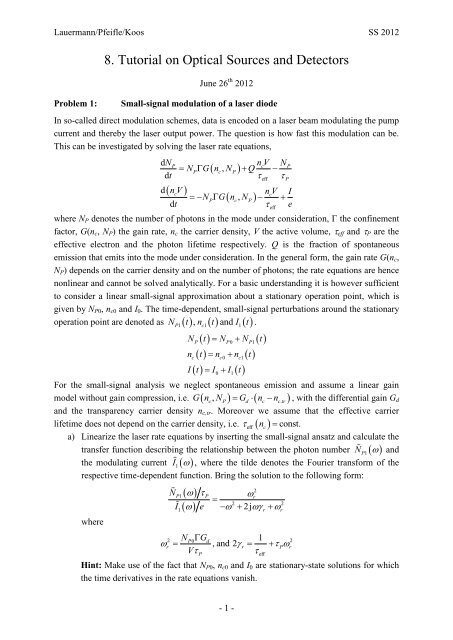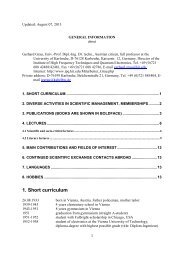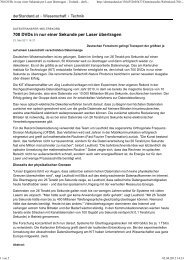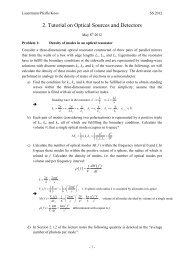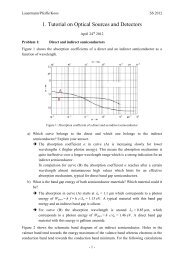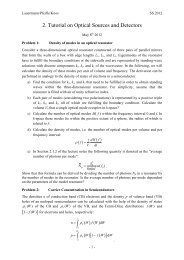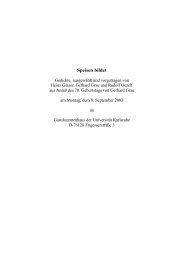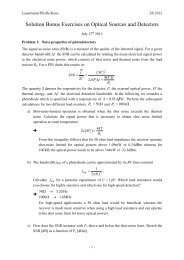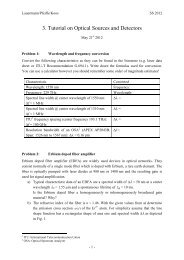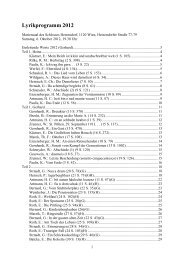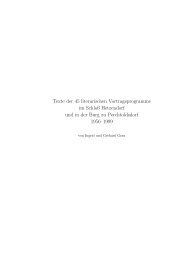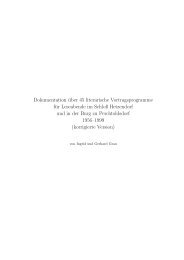Exercise 08 - IPQ - KIT
Exercise 08 - IPQ - KIT
Exercise 08 - IPQ - KIT
Create successful ePaper yourself
Turn your PDF publications into a flip-book with our unique Google optimized e-Paper software.
Lauermann/Pfeifle/Koos SS 2012<br />
Problem 1:<br />
8. Tutorial on Optical Sources and Detectors<br />
June 26 th 2012<br />
Small-signal modulation of a laser diode<br />
In so-called direct modulation schemes, data is encoded on a laser beam modulating the pump<br />
current and thereby the laser output power. The question is how fast this modulation can be.<br />
This can be investigated by solving the laser rate equations,<br />
dN<br />
dt<br />
d<br />
<br />
P<br />
nV<br />
c<br />
N<br />
NPG nc , NP<br />
Q <br />
<br />
<br />
nV<br />
c<br />
nV<br />
c<br />
I<br />
NPG nc , NP<br />
<br />
dt<br />
e<br />
where N P denotes the number of photons in the mode under consideration, the confinement<br />
factor, G(n c , N P ) the gain rate, n c the carrier density, V the active volume, eff and P are the<br />
effective electron and the photon lifetime respectively. Q is the fraction of spontaneous<br />
emission that emits into the mode under consideration. In the general form, the gain rate G(n c ,<br />
N P ) depends on the carrier density and on the number of photons; the rate equations are hence<br />
nonlinear and cannot be solved analytically. For a basic understanding it is however sufficient<br />
to consider a linear small-signal approximation about a stationary operation point, which is<br />
given by N P0 , n c0 and I 0 . The time-dependent, small-signal perturbations around the stationary<br />
N t , n t and I t .<br />
operation point are denoted as<br />
P1 c1 1 <br />
NP t<br />
NP0 NP<br />
1t<br />
nc t<br />
nc 0<br />
nc<br />
1t<br />
I t<br />
I I t<br />
0 1<br />
For the small-signal analysis we neglect spontaneous emission and assume a linear gain<br />
model without gain compression, i.e. Gnc , NP Gd nc nc.<br />
tr , with the differential gain G d<br />
and the transparency carrier density n c,tr . Moreover we assume that the effective carrier<br />
lifetime does not depend on the carrier density, i.e. <br />
eff n c const.<br />
a) Linearize the laser rate equations by inserting the small-signal ansatz and calculate the<br />
transfer function describing the relationship between the photon number NP1<br />
and<br />
the modulating current I1<br />
, where the tilde denotes the Fourier transform of the<br />
respective time-dependent function. Bring the solution to the following form:<br />
where<br />
N<br />
<br />
<br />
<br />
<br />
<br />
eff<br />
eff<br />
2<br />
P1<br />
P r<br />
<br />
2 2<br />
I1 e 2j r r<br />
N G<br />
1<br />
, and 2 <br />
2 P0<br />
d<br />
2<br />
r r P r<br />
VP<br />
eff<br />
Hint: Make use of the fact that N P0 , n c0 and I 0 are stationary-state solutions for which<br />
the time derivatives in the rate equations vanish.<br />
P<br />
P<br />
- 1 -
Lauermann/Pfeifle/Koos SS 2012<br />
max<br />
b) For a given relaxation frequency r , what is the maximum 3dB bandwidth <br />
3dB<br />
of the<br />
laser and for which value of r can it be achieved. The value corresponds to the case of<br />
critical damping.<br />
Note: The 3dB bandwidth 3dB is defined as<br />
<br />
<br />
<br />
<br />
N P 1<br />
3dB<br />
P<br />
I<br />
<br />
1 3dB<br />
e<br />
1<br />
.<br />
2<br />
c) To increase the modulation speed of a laser, the relaxation frequency r should be<br />
maximized. Discuss different design approaches that allow to increase r and shortly<br />
explain the physical mechanisms behind them.<br />
Questions and Comments:<br />
Matthias Lauermann<br />
Jörg Pfeifle<br />
Building: 30.10, Room: 2.23 Building: 30.10, Room: 2.23<br />
Phone: 0721/6<strong>08</strong>-48954 Phone: 0721/6<strong>08</strong>-48954<br />
Email: Matthias.Lauermann@kit.edu<br />
Email: Joerg.Pfeifle@kit.edu<br />
- 2 -


